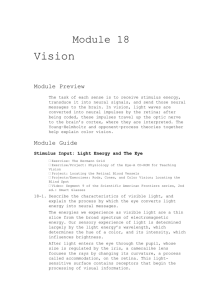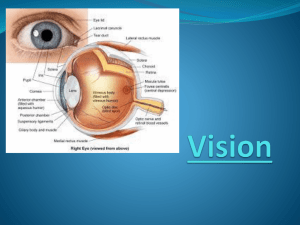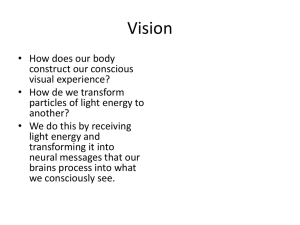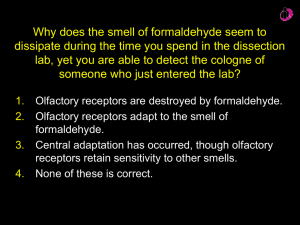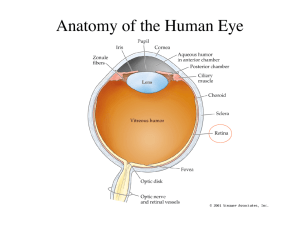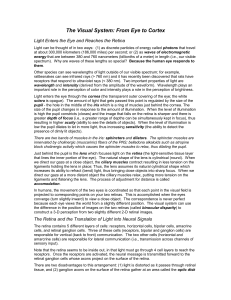Chapter Summary Visual Stimulus Light is part of the
advertisement
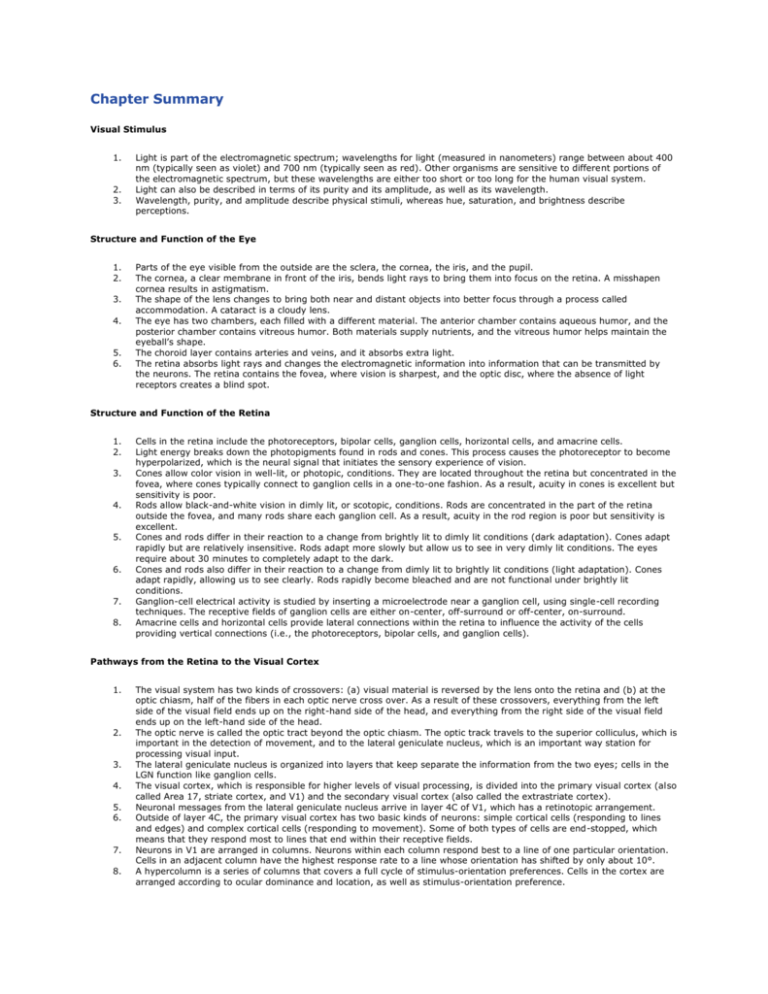
Chapter Summary Visual Stimulus 1. 2. 3. Light is part of the electromagnetic spectrum; wavelengths for light (measured in nanometers) range between about 400 nm (typically seen as violet) and 700 nm (typically seen as red). Other organisms are sensitive to different portions of the electromagnetic spectrum, but these wavelengths are either too short or too long for the human visual system. Light can also be described in terms of its purity and its amplitude, as well as its wavelength. Wavelength, purity, and amplitude describe physical stimuli, whereas hue, saturation, and brightness describe perceptions. Structure and Function of the Eye 1. 2. 3. 4. 5. 6. Parts of the eye visible from the outside are the sclera, the cornea, the iris, and the pupil. The cornea, a clear membrane in front of the iris, bends light rays to bring them into focus on the retina. A misshapen cornea results in astigmatism. The shape of the lens changes to bring both near and distant objects into better focus through a process called accommodation. A cataract is a cloudy lens. The eye has two chambers, each filled with a different material. The anterior chamber contains aqueous humor, and the posterior chamber contains vitreous humor. Both materials supply nutrients, and the vitreous humor helps maintain the eyeball’s shape. The choroid layer contains arteries and veins, and it absorbs extra light. The retina absorbs light rays and changes the electromagnetic information into information that can be transmitted by the neurons. The retina contains the fovea, where vision is sharpest, and the optic disc, where the absence of light receptors creates a blind spot. Structure and Function of the Retina 1. 2. 3. 4. 5. 6. 7. 8. Cells in the retina include the photoreceptors, bipolar cells, ganglion cells, horizontal cells, and amacrine cells. Light energy breaks down the photopigments found in rods and cones. This process causes the photoreceptor to become hyperpolarized, which is the neural signal that initiates the sensory experience of vision. Cones allow color vision in well-lit, or photopic, conditions. They are located throughout the retina but concentrated in the fovea, where cones typically connect to ganglion cells in a one-to-one fashion. As a result, acuity in cones is excellent but sensitivity is poor. Rods allow black-and-white vision in dimly lit, or scotopic, conditions. Rods are concentrated in the part of the retina outside the fovea, and many rods share each ganglion cell. As a result, acuity in the rod region is poor but sensitivity is excellent. Cones and rods differ in their reaction to a change from brightly lit to dimly lit conditions (dark adaptation). Cones adapt rapidly but are relatively insensitive. Rods adapt more slowly but allow us to see in very dimly lit conditions. The eyes require about 30 minutes to completely adapt to the dark. Cones and rods also differ in their reaction to a change from dimly lit to brightly lit conditions (light adaptation). Cones adapt rapidly, allowing us to see clearly. Rods rapidly become bleached and are not functional under brightly lit conditions. Ganglion-cell electrical activity is studied by inserting a microelectrode near a ganglion cell, using single-cell recording techniques. The receptive fields of ganglion cells are either on-center, off-surround or off-center, on-surround. Amacrine cells and horizontal cells provide lateral connections within the retina to influence the activity of the cells providing vertical connections (i.e., the photoreceptors, bipolar cells, and ganglion cells). Pathways from the Retina to the Visual Cortex 1. 2. 3. 4. 5. 6. 7. 8. The visual system has two kinds of crossovers: (a) visual material is reversed by the lens onto the retina and (b) at the optic chiasm, half of the fibers in each optic nerve cross over. As a result of these crossovers, everything from the left side of the visual field ends up on the right-hand side of the head, and everything from the right side of the visual field ends up on the left-hand side of the head. The optic nerve is called the optic tract beyond the optic chiasm. The optic track travels to the superior colliculus, which is important in the detection of movement, and to the lateral geniculate nucleus, which is an important way station for processing visual input. The lateral geniculate nucleus is organized into layers that keep separate the information from the two eyes; cells in the LGN function like ganglion cells. The visual cortex, which is responsible for higher levels of visual processing, is divided into the primary visual cortex (also called Area 17, striate cortex, and V1) and the secondary visual cortex (also called the extrastriate cortex). Neuronal messages from the lateral geniculate nucleus arrive in layer 4C of V1, which has a retinotopic arrangement. Outside of layer 4C, the primary visual cortex has two basic kinds of neurons: simple cortical cells (responding to lines and edges) and complex cortical cells (responding to movement). Some of both types of cells are end-stopped, which means that they respond most to lines that end within their receptive fields. Neurons in V1 are arranged in columns. Neurons within each column respond best to a line of one particular orientation. Cells in an adjacent column have the highest response rate to a line whose orientation has shifted by only about 10°. A hypercolumn is a series of columns that covers a full cycle of stimulus-orientation preferences. Cells in the cortex are arranged according to ocular dominance and location, as well as stimulus-orientation preference. 9. 10. 11. 12. 13. Located within a hypercolumn are regions of cells that are not orientation sensitive. These regions are called blobs, and they are important for color perception. Between blobs is a region of neurons called interblob cells. Three visual pathways (P, M, and K) originate in the retina with different gaglion cells (midget, parasol, and small bistratified). Each pathway has different characteristics and functions. The secondary visual cortex receives information from the primary visual cortex. Within the secondary visual cortex are two important pathways: the Where pathway and the What pathway. The Where pathway is important for spatial location; it runs from the primary visual cortex through the secondary visual cortex to the parietal lobe. The What pathway is important for object recognition; it runs from the primary visual cortex through the secondary visual cortex to the temporal lobe. People with agnosia have basic visual abilities but cannot recognize objects. Thus, they can see all the detail in a picture and draw a clear picture of the object they are looking at. However, they cannot recognize the object depicted in their own drawing. People with prosopagnosia have a specific agnosia for faces.
